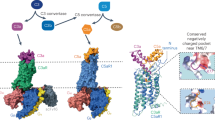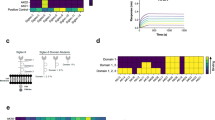Abstract
High-dose intravenous immunoglobulin (IVIG) prevents immune damage by scavenging complement fragments C3b and C4b. We tested the hypothesis that exogenous immunoglobulin molecules also bind anaphylatoxins C3a and C5a, thereby neutralizing their pro-inflammatory effects. Single-cell calcium measurements in HMC-1 human mast cells showed that a rise in intracellular calcium caused by C3a and C5a was inhibited in a concentration-dependent manner by IVIG, F(ab)′2-IVIG and irrelevant human monoclonal antibody. C3a- and C5a-induced thromboxane (TXB2) generation and histamine release from HMC-1 cells and whole-blood basophils were also suppressed by exogenous immunoglobulins. In a mouse model of asthma, immunoglobulin treatment reduced cellular migration to the lung. Lethal C5a-mediated circulatory collapse in pigs was prevented by pretreatment with F(ab)′2-IVIG. Molecular modeling, surface plasmon resonance (SPR) and western blot analyses suggested a physical association between anaphylatoxins and the constant region of F(ab)′2. This binding could interfere with the role of C3a and C5a in inflammation.
This is a preview of subscription content, access via your institution
Access options
Subscribe to this journal
Receive 12 print issues and online access
$209.00 per year
only $17.42 per issue
Buy this article
- Purchase on Springer Link
- Instant access to full article PDF
Prices may be subject to local taxes which are calculated during checkout





Similar content being viewed by others
References
Dwyer, J.M. Manipulating the immune system with immune globulin. N. Engl. J. Med. 326, 107–116 (1992).
Basta, M., Kirshbom, P., Frank, M.M. & Fries, L.F. Mechanism of therapeutic effect of high-dose intravenous immunoglobulin. Attenuation of acute, complement-dependent immune damage in a guinea pig model. J. Clin. Invest. 84, 1974–1981 (1989).
Basta, M., Langlois, P.F., Marques, M.M., Frank, M.M. & Fries, L.F. High-dose intravenous immunoglobulin modifies complement-mediated in vivo clearance. Blood 74, 326–333 (1989).
Basta, M., Fries, L.F. & Frank, M.M. High doses of intravenous Ig inhibit in vitro uptake of C4 fragments onto sensitized erythrocytes. Blood 77, 376–380 (1991).
Basta, M., Fries, L.F. & Frank, M.M. High doses of intravenous immunoglobulin do not affect the recognition phase of the classical complement pathway. Blood 78, 700–702 (1991).
Basta, M. & Dalakas, M.C. High-dose intravenous immunoglobulin exerts its beneficial effect in patients with dermatomyositis by blocking endomysial deposition of activated complement fragments. J. Clin. Invest. 4, 1729–1735 (1994).
Basta, M., Illa, I. & Dalakas, M.C. Increased in vitro uptake of the complement C3b in the serum of patients with Guillain-Barré syndrome, myasthenia gravis and dermatomyositis. J. Neuroimmunol. 71, 227–229 (1996).
Basta, M. Modulation of complement-mediated immune damage by intravenous immune globulin. Clin. Exp. Immunol. 104 (suppl. 1), 21–25 (1996).
Ember, J.E. & Hugli, T.E. Complement factors and their receptors. Immunopharmacology 38, 3–15 (1997).
Hugli, T.E. Structure and function of C3a anaphylatoxin. Curr. Top. Microbiol. Immunol. 153, 181–208 (1989).
DeBoer, J.P. et al. Interplay of complement and cytokines in the pathogenesis of septic shock. Immunopharmacology 24, 135–148 (1992).
Nezlin, R. & Freywald, A. Complexes of IgG molecules and C3a and C4a complement components in human serum. Eur. J. Immunol. 22, 1955–1957 (1992).
Nezlin, R., Freywald, A. & Oppermann, M. Proteins separated from human IgG molecules. Mol. Immunol. 30, 935–940 (1992).
Nezlin, R. Detection of C3a complement component in commercial gamma globulins by dot blotting. J. Immunol. Methods. 163, 269–272 (1993).
Nilsson, G. et al. C3a and C5a are chemotactic for human mast cells and act through distinct receptors via a pertusis toxin-sensitive signal transduction pathway. J. Immunol. 157, 1693–1698 (1996).
Oppermann, M., Hopken, U. & Gotze, O. Assessment of complement activation in vivo. Immunopharmacology 24, 119–134 (1992).
Kekow, J., Reinhold, D., Pap, T. & Ansorge, S. Intravenous immunoglobulins and transforming growth factor β. Lancet 351, 184–185 (1998).
Campbell, W., Okada, N. & Okada, H. Carboxypeptidase R is an indicator of complement-derived inflammation peptides and an inhibitor of fibrinolysis. Immunol. Rev. 180, 162–167 (2001).
Hartung, H.P., Bitter-Suermann, D. & Haddin, U. Induction of thromboxane release from macrophages by anaphylatoxic peptide C3a of complement and synthetic hexapeptide C3a 72-77. J. Immunol. 130, 1345–1349 (1983).
Pauwels, R.A., Brusselle, G.G., Tourney, K.G., Lambrecht, B.N. & Kips, J.C. Cytokines and their receptors as therapeutic targets in asthma. Clin. Exp. Allergy 28 (suppl. 3), 1–5 (1998).
Szebeni, J. et al. Hemodynamic changes induced by liposomes and liposome- encapsulated hemoglobin in pigs. A model for pseudoallergic cardiopulmonary reactions to liposomes: role of complement and inhibition by soluble CR1 and anti-C5a antibody. Circulation 99, 2302–2309 (1999).
Humbles, A.A. et al. A role of the C3a anaphylatoxin receptor in the effector phase of asthma. Nature 406, 998–1001 (2000).
Bautsch, W. et al. Guinea pigs with a natural C3a receptor defect exhibit decreased bronchoconstriction in allergic airway disease: evidence for an involvement of the C3a anaphylatoxin in the pathogenesis of asthma. J. Immunol. 165, 5401–5405 (2000).
Samuelsson, A., Towers, T.L. & Ravetch, J.V. Anti-inflammatory activity of IVIG mediated through the inhibitory Fc receptor. Science 29, 484–486 (2001).
Clynes, R. et al. Modulation of immune complex-induced inflammation in vivo by the coordinate expression of activation and inhibitory Fc receptors. J. Exp. Med. 189, 179–185 (1999).
Frank, M.M. & Fries, LF. in Fundamental Immunology 2nd edn. (ed. Paul, W.E.) 686–687 (Raven Press, New York, New York, 1989).
Platt, J.L., Dalmasso, A.P., Lindman, B.J., Ihrcke, N.S. & Bach, F. The role of C5a and antibody in the release of heparan sulfate from endothelial cells. Eur. J. Immunol. 21, 2887–2890 (1991).
Morgan, E.L. Modulation of the immune response by anaphylatoxins. Complement 3, 128–136 (1986).
Morgan, E.L., Thoman, M.L., Weigle, W.O. & Hugli, T.E. Anaphylatoxin-mediated regulation of the immune response. II. C5a-mediated enhancement of human humoral and T-cell-mediated immune responses. J. Immunol. 130, 1257–1266 (1983).
Weigle, W.O., Goodman, M.G., Morgan, E.L. & Hugli, T.E. Regulation of immune response by components of the complement cascade and their activated fragments. Springer Semin. Immunopath. 6, 173–194 (1983).
Butterfield, J.H, Weiler, D., Dewald, D. & Gleich, G.J. Establishment of an immature mast cell line from a patient with mast cell leukemia. Leuk. Res. 12, 345–355 (1988).
Komura, H. et al. Effect of anticoagulants in colorimetric assay for basic carboxypeptidases. Microbiol. Immunol. 46, 115–117 (2002).
Fisher, M.B. et al. Regulation of the cell response to T-dependent antigens by classical pathway complement. J. Immunol. 157, 549–556 (1996).
Luccioli, S. et al. IgE+, Kit−, I-A/I-E− myeloid cells are the initial source of IL-4 after antigen challenge in a mouse model of allergic inflammation. J. Allergy Clin. Immunol. 110, 117–124
Maizel, J.V. Polyacrylamide gel electrophoresis of viral proteins. Meth. Virol. 5, 179–183 (1979).
Brooks, B.R. et al. CHARMM: a program for macromolecular energy, minimization, and dynamic calculations. J. Comput. Chem. 4, 187–217 (1983).
Zhang, T. & Koshland, D.E. Computational method for relative binding energies of enzyme-substrate complexes. Protein Sci. 5, 348–356 (1996).
Baranyi, L. et al. Antisense homology box-derived peptides represent a new class of endothelin receptor inhibitors. Peptides 19, 211–223 (1998).
Acknowledgements
The authors thank T. Semere for his help with HMC-1 cell cultures; M. Opperman for monoclonal antibodies against C3a and C5a; P. Gronski for purified F(ab)′2 immunoglobulin fragments and IVIG preparations (GammaVenin and Venimmun); R. Huber for the X-ray structures of the C3a molecule; E. Padlan for the X-ray and model structures of the Fab fragment of IgG; and B. Kelsall and P. Murphy for critical reading of the manuscript and helpful suggestions.
Author information
Authors and Affiliations
Corresponding author
Ethics declarations
Competing interests
The authors declare no competing financial interests.
Rights and permissions
About this article
Cite this article
Basta, M., Van Goor, F., Luccioli, S. et al. F(ab)′2-mediated neutralization of C3a and C5a anaphylatoxins: a novel effector function of immunoglobulins. Nat Med 9, 431–438 (2003). https://doi.org/10.1038/nm836
Received:
Accepted:
Published:
Issue Date:
DOI: https://doi.org/10.1038/nm836
This article is cited by
-
What are the current anti-COVID-19 drugs? From traditional to smart molecular mechanisms
Virology Journal (2023)
-
Evidence, detailed characterization and clinical context of complement activation in acute multisystem inflammatory syndrome in children
Scientific Reports (2022)
-
Efficacy and safety of intravenous high-dose immunoglobulin in treatment of the severe form of Japanese encephalitis
Neurological Sciences (2022)
-
Carboxypeptidase B blocks ex vivo activation of the anaphylatoxin-neutrophil extracellular trap axis in neutrophils from COVID-19 patients
Critical Care (2021)
-
Role of complement and potential of complement inhibitors in myasthenia gravis and neuromyelitis optica spectrum disorders: a brief review
Journal of Neurology (2021)



